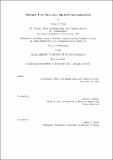| dc.contributor.author | Yen, Brent J. | |
| dc.date.accessioned | 2004-10-07T14:56:53Z | |
| dc.date.available | 2004-10-07T14:56:53Z | |
| dc.date.issued | 2004-10-07T14:56:53Z | |
| dc.identifier.uri | http://hdl.handle.net/1721.1/6567 | |
| dc.description | Thesis Supervisor: Jeffrey H. Shapiro
Title: Julius A. Stratton Professor of Electrical Engineering | en |
| dc.description.abstract | A fundamental understanding of the information carrying capacity of optical channels requires the signal and physical channel to be modeled quantum mechanically. This thesis
considers the problems of distributing multi-party quantum entanglement to distant users in a quantum communication system and determining the ability of quantum optical channels
to reliably transmit information.
A recent proposal for a quantum communication architecture that realizes long-distance,
high-fidelity qubit teleportation is reviewed. Previous work on this communication architecture is extended in two primary ways. First, models are developed for assessing the effects of
amplitude, phase, and frequency errors in the entanglement source of polarization-entangled
photons, as well as fiber loss and imperfect polarization restoration, on the throughput and
fidelity of the system. Second, an error model is derived for an extension of this communication architecture that allows for the production and storage of three-party entangled
Greenberger-Horne-Zeilinger states. A performance analysis of the quantum communication
architecture in qubit teleportation and quantum secret sharing communication protocols is
presented.
Recent work on determining the channel capacity of optical channels is extended in several ways. Classical capacity is derived for a class of Gaussian Bosonic channels representing
the quantum version of classical colored Gaussian-noise channels. The proof is strongly mo-
tivated by the standard technique of whitening Gaussian noise used in classical information
theory. Minimum output entropy problems related to these channel capacity derivations
are also studied. These single-user Bosonic capacity results are extended to a multi-user
scenario by deriving capacity regions for single-mode and wideband coherent-state multiple
access channels. An even larger capacity region is obtained when the transmitters use non-
classical Gaussian states, and an outer bound on the ultimate capacity region is presented | en |
| dc.description.sponsorship | DoD Multidisciplinary University Research Initiative (MURI) program administered by the Army Research Office and the Quantum Information Science and Technology Program under Army Reserach Office. | en |
| dc.format.extent | 1030005 bytes | |
| dc.format.mimetype | application/pdf | |
| dc.language.iso | en | |
| dc.relation.ispartofseries | Technical Report(Massachusetts Institute of Technology, Research Laboratory of Electronics);707 | |
| dc.title | Multiple-User Quantum Optical Communication | en |
| dc.type | Technical Report | en |
